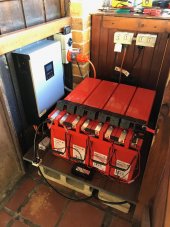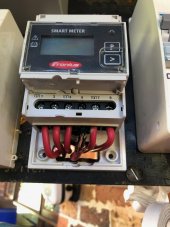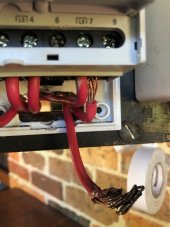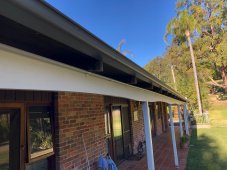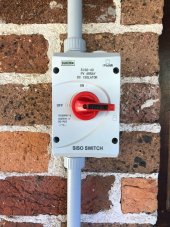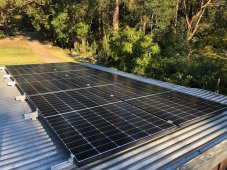wattmatters
Solar Wizard
Greetings from down under. I live in a home near the small town of Bellingen, in northern NSW, Australia. Glorious country:

That's our home at left centre, and obscured by the tree and slightly off the left of the image is a secondary dwelling where my Mum lives. 12 acres, behind our home (to the left) is bushland. Aside from that, the beach I take our dog to is 20-min away:

We've been here living the dream for a little over five years now.
While semi-rural (~1km out of town) we have 3-phase grid connected power. What you can't see in the pic above is another building which was originally a builder's workshop, hence the 3-phase supply. That building was in ruins when we got here but I have resurrected it and created a mancave escape with 115m² of indoor mancave goodness.
Before:

After:

Has since been decked out with bed, furniture, storage, workbenches and is a self contained living space / office / workshop / training facility.
I had installed an 11kW grid tied solar PV array, with a Fronius Symo inverter on the primary dwelling:

It's great, has made a massive difference to our power bills and our investment will be recovered inside of 5 years. Our home is all electric except for the hot water in the second dwelling and mancave which each have Rinnai continuous flow gas HW units with 45kg propane tanks. Heating/cooling is all via reverse cycle aircon. Apart from working on the energy supply side with the solar PV, we've also made a few changes on the energy demand side and have managed to reduce our average electrical energy consumption over the past 5 years by 19kWh/day.
That's the good stuff. The downside is rural electrical supply is less reliable than what I was used to when we lived in inner Sydney. With the Fronius meter data I collect, I have been able to keep a complete record of our grid outages and each year we average a dozen longer outages totalling about 36 hours. Plus a lot of shorter brown-out type outages. It's seasonal, with Summer storms being responsible for half the outages.
The longest was a 2-3 days outage after a mini cyclone took out power lines across the district, and it was when we had family staying for holidays with fridges full of all our Christmas food and goodies. Not happy Jan.
It was clear based on our experience over several years that grid outages were going to be an ongoing fact of life here so I did what most probably do and started with a small cheapie generator and lots of extension cords. That was OK and got us through a few outages but it was tedious to set up and put away again, only to have another outage soon after. And once we decided to build the extra dwelling for my elderly Mum to live in, well we were going to need a better solution for some energy security.
So about 18 months ago I decided it was time to have backup power supply wired into the main circuit board. Keeping it simple I started with a 15A power inlet (we are 230V AC here, so that’s enough to handle 3.5kW) which can supply all the home’s circuits via a cutover switch.

While the home is supplied via 3-phase, when on back up supply the home is effectively on a single phase supply. We have no 3-phase appliances or loads, and if we did they would not be connected to the backup side of the cutover switch in any case. I kept the oven and induction stove on the grid-only side - and the oven clock tells us when the grid power comes back on, it also makes a bleeping sound on power up so we know when we can cut back over to grid power.
I bought a pre-loved Yamaha EF3000iSE inverter generator with keyed electric start in near new condition for half the new price. It’ll supply up to 2.8kW continuous without problem. It’s quiet and easy to start/use and this has been our mainstay for power backup and we’ve been very glad to have it.
However, despite how easy it is to use, the wife is still not keen all that keen on using the generator when I’m not home, plus if we were both not home my Mum would have little hope of turning it on.
Hence I wanted to move up another step with our backup power system to make it even easier to use and also provide automation for my Mum for the occasions when we are both away.
So I’ve started an off-grid inverter/battery/solar project. Since this post has been long enough already, I’ll end it here and next post will be about that part of the project.

That's our home at left centre, and obscured by the tree and slightly off the left of the image is a secondary dwelling where my Mum lives. 12 acres, behind our home (to the left) is bushland. Aside from that, the beach I take our dog to is 20-min away:

We've been here living the dream for a little over five years now.
While semi-rural (~1km out of town) we have 3-phase grid connected power. What you can't see in the pic above is another building which was originally a builder's workshop, hence the 3-phase supply. That building was in ruins when we got here but I have resurrected it and created a mancave escape with 115m² of indoor mancave goodness.
Before:

After:

Has since been decked out with bed, furniture, storage, workbenches and is a self contained living space / office / workshop / training facility.
I had installed an 11kW grid tied solar PV array, with a Fronius Symo inverter on the primary dwelling:

It's great, has made a massive difference to our power bills and our investment will be recovered inside of 5 years. Our home is all electric except for the hot water in the second dwelling and mancave which each have Rinnai continuous flow gas HW units with 45kg propane tanks. Heating/cooling is all via reverse cycle aircon. Apart from working on the energy supply side with the solar PV, we've also made a few changes on the energy demand side and have managed to reduce our average electrical energy consumption over the past 5 years by 19kWh/day.
That's the good stuff. The downside is rural electrical supply is less reliable than what I was used to when we lived in inner Sydney. With the Fronius meter data I collect, I have been able to keep a complete record of our grid outages and each year we average a dozen longer outages totalling about 36 hours. Plus a lot of shorter brown-out type outages. It's seasonal, with Summer storms being responsible for half the outages.
The longest was a 2-3 days outage after a mini cyclone took out power lines across the district, and it was when we had family staying for holidays with fridges full of all our Christmas food and goodies. Not happy Jan.
It was clear based on our experience over several years that grid outages were going to be an ongoing fact of life here so I did what most probably do and started with a small cheapie generator and lots of extension cords. That was OK and got us through a few outages but it was tedious to set up and put away again, only to have another outage soon after. And once we decided to build the extra dwelling for my elderly Mum to live in, well we were going to need a better solution for some energy security.
So about 18 months ago I decided it was time to have backup power supply wired into the main circuit board. Keeping it simple I started with a 15A power inlet (we are 230V AC here, so that’s enough to handle 3.5kW) which can supply all the home’s circuits via a cutover switch.

While the home is supplied via 3-phase, when on back up supply the home is effectively on a single phase supply. We have no 3-phase appliances or loads, and if we did they would not be connected to the backup side of the cutover switch in any case. I kept the oven and induction stove on the grid-only side - and the oven clock tells us when the grid power comes back on, it also makes a bleeping sound on power up so we know when we can cut back over to grid power.
I bought a pre-loved Yamaha EF3000iSE inverter generator with keyed electric start in near new condition for half the new price. It’ll supply up to 2.8kW continuous without problem. It’s quiet and easy to start/use and this has been our mainstay for power backup and we’ve been very glad to have it.
However, despite how easy it is to use, the wife is still not keen all that keen on using the generator when I’m not home, plus if we were both not home my Mum would have little hope of turning it on.
Hence I wanted to move up another step with our backup power system to make it even easier to use and also provide automation for my Mum for the occasions when we are both away.
So I’ve started an off-grid inverter/battery/solar project. Since this post has been long enough already, I’ll end it here and next post will be about that part of the project.



